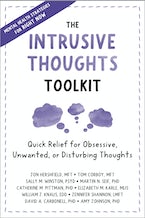By Jon Hershfield, MFT, Tom Corboy, MFT, Sally M. Winston, PsyD, Martin N. Seif, PhD, Catherine M. Pittman, PhD, Elizabeth M. Karle, MLIS, William J. Knaus, EdD, Jennifer Shannon, LMFT, David A. Carbonell, PhD and Amy Johnson, PhD, coauthors of The Intrusive Thoughts Toolkit
Understanding Intrusive Thoughts
Just about everyone has intrusive thoughts. They are uninvited thoughts that jump into the mind and do not seem to be part of the ongoing flow of intentional thinking. Intrusive thoughts are common, but for most people they are quickly forgotten and create minimal or no discomfort. For someone who isn’t struggling with or worrying about intrusive thoughts, they provide weird, uncomfortable, or even funny moments…and then they are over. Sometimes they startle. Most intrusive thoughts—no matter how bizarre or repugnant—occupy only a few moments. People rarely mention them or think about them again. They’re just not worth mentioning (unless they are really funny).
There are times when anyone can be reminded of a previous intrusive thought and shake their head, Oh I remember that this is the elevator where I had that utterly weird experience of thinking that I was going to suddenly shout out an obscenity. Sometimes—for a while—elevators and thoughts about shouting out obscenities get temporarily stuck to each other. One is associated with the other. It means nothing. The human mind just makes associations like that automatically. The experience, while strange, is unimportant and goes away.
An unwanted intrusive thought starts as just an ordinary intrusive thought, weird, funny, or repugnant as it may be. But not wanting the thought, worrying about it, or fighting with it stops it from passing quickly.
Chances are, you don’t want it because you’re upset or turned off by the content.
But that is just the beginning. Because you worry about it, reject it, and try to push it out of your mind, it pushes back and becomes a recurring thought or image.
After a while, it starts to redirect your attention: It starts arriving with a “whoosh,” and feels awful, disgusting, or dreaded. It contains an urgent feeling of needing to get rid of it. The content of many
unwanted intrusive thoughts is aggressive, sexual, taboo, anxiety-provoking, or self-derogatory.
Your efforts to deal with it become all-encompassing and take up so much time, mental energy, and focus that your quality of life is degraded.
Unwanted intrusive thoughts tend to recur repeatedly and seem to increase in intensity over time. Eventually, along with an increase in the frequency and intensity of the thoughts themselves, you might start to doubt and fear your own intentions, morality, self-control, and sanity.
What to Do
Accept and allow the thoughts in your mind. Do not try to push them away. This is a complicated suggestion, but for the present, your job is not to distract, not to engage, and not to reason away.
Don’t allow yourself to start exploring the ideas or content of your thoughts. Don’t try to come up with a plan or solve any problem that appears to be created by your thought. When you do this, you’re
trying to figure out the answer to a problem that has no answer. Furthermore, it is not a problem!
Accept and allow means that you’re actively allowing the thoughts to be there, not wishing they were gone, because this attitude helps you grasp that the thoughts are unimportant. They do not require any
attention or response. You might even welcome the thoughts as another opportunity to teach the brain a different way.
Intrusive Thoughts are Normal
The fact is that everyone has passing weird, aggressive, or crazy thoughts. If every thought spoke to our underlying character, then 90 percent of people would be weird, aggressive, or crazy. That is because about 90 percent of people acknowledge having intrusive thoughts that they characterize as weird, aggressive, frightening, or crazy. And think about some of the horror movies and TV shows that are so popular these days. Perhaps you’re unable to watch them because they trigger too much fear. But remember that these awful, weird, aggressive, and crazy scenarios are thought up by normal, creative people. They are simply writing scripts that other people will want to watch.
It’s a myth that weird or nonsensical thoughts indicate loss of control over your mind or even mental illness. It’s also false that if you have repugnant intrusive thoughts, it could mean that you’re a perverted or disgusting person.
People with unwanted aggressive or violent thoughts may become fearful that they are violent or angry despite having no awareness of these emotions, and that their true feelings are indicated by these thoughts. Not only may they come to believe that they must be bad people at their core, but they may also feel an extra burden to exercise serious control over these thoughts.
The truth is we all have mental activity going on outside of awareness, and it’s interesting to wonder how certain mental events happen to pop up. But there is no truth to the idea that blips of intrusive 16 thoughts and images reveal underlying truths. It is not true that intrusive thoughts reveal motives, feelings, and intentions that are deeply meaningful or contain messages that need to be addressed when they differ from conscious thoughts, feeling, and intentions.
What to Do
Allow time to pass. Don’t urge it on. Observe your anxiety and distress from a curious, disinterested point of view. Do not keep checking to see if this is working; just let the thoughts be there. They are thoughts. There is no hurry. Allowing time to pass is one of the most important skills for recovery. Remember that any thought that produces a repeated feeling of urgency is a sign of anxiety. A feeling of urgency is discomfort, not danger. It comes automatically with the thoughts, but it is not a signal for action.
Slow down. Let it be. You are dealing with discomfort, not danger. Time allows your normal calming reaction to take effect, on its own, naturally.
PP. 6-7, 15-16 Excerpt taken from The Intrusive Thoughts Toolkit
Written by a team of mental health experts and grounded in evidence-based therapy, Intrusive Thoughts Toolkit provides fast-acting tools for soothing distressing thoughts in the moments when you need it most. With this take-anywhere guide, you’ll learn proven techniques to get unstuck from negative thoughts and feelings, adopt healthier thinking habits, and increase overall well-being.



 2024 Peace Playbook: 3 Tactics to Avoid Clashes with Your Partner
2024 Peace Playbook: 3 Tactics to Avoid Clashes with Your Partner